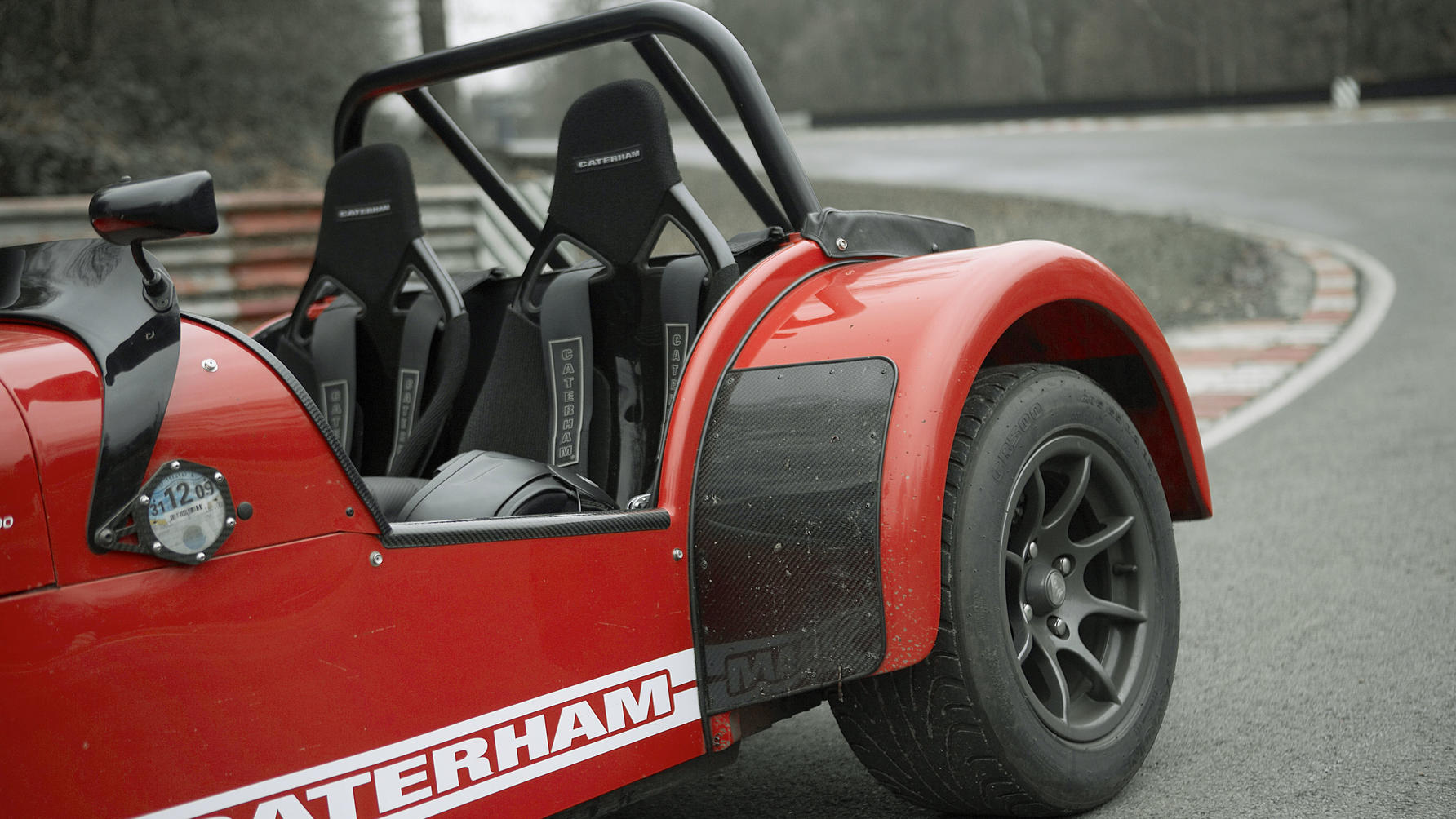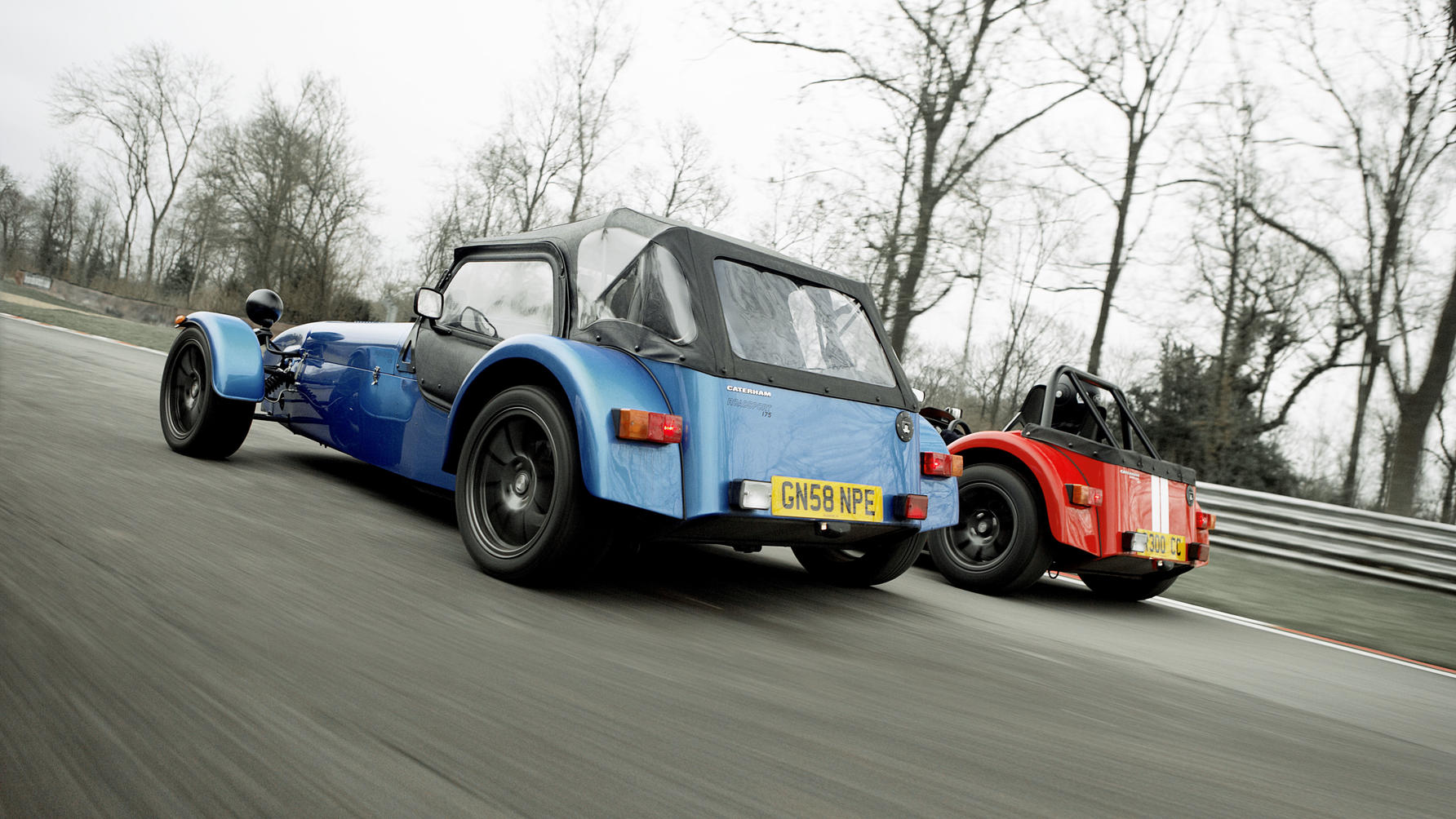
From the archives: Caterham Roadsport 175 vs Superlight R300
A throwback to 2009, when the trackday mentalist R300 met the practical Roadsport 175. But can a Caterham ever really be ‘practical’?
Put your ego aside for a moment and consider this: both of these Caterhams share the same 175bhp, 2.0-litre Ford motor and the same basic structure. But one of them has a more user-friendly five-speed ’box, more room in the widebody SV chassis, a windscreen, a heater and a roof, whereas the other one has an extra gear, a limited-slip diff, more carbon fibre and less of pretty much everything else; less weight, less windscreen, just a lot more less. So which one do you reckon is more fun, more of the time? The B-road friendly Caterham Roadsport 175, or the barely road-legal Caterham Superlight R300?
This feature was first published in Issue 193 of Top Gear magazine (2009)
Images: Lee Brimble
Of course most of us will immediately opt for the Superlight. Why? Because ‘compromise’ is a rubbish word. It’s full of unsatisfying connotations, of middle-grounds and nearly-but-not-quites. It’s a word that makes you sensible, weighs you down with responsibility and middle-managed greyness. The Roadsport is obviously a compromise, and obvious compromises do not win you admiring glances. But surely a car set up for the real world will let you extract more fun, more of the time? Is this where you should be looking for reliable, accessible thrills rather than the very hard-to-reach highs of a more committed car? Is softcore the new hardcore?
The basics: Caterham has conceived the Roadsport as an ‘all-seasons’ Seven, rather than a dry-weekend warrior, the theory being that with a more benign specification, you’ll be able to use the car more (even if it is a lower intensity) and therefore get more from it in the long term. The Roadsport isn’t track-biased, and comes kitted out with a roof, windscreen,15-inch alloys, heater, full carpets and all the rest of the gubbins. You can even have a radio. There’s no LSD as standard, but you do get a five-speed gearbox with longer ratios for less gearchanging, armrests and big fat seats in an attempt to make it more comfy. Essentially this is Caterham’s version of the Maybach.
Which lulls you into a false sense of security, because under the veneer, this is just an R300 in an ill-fitting hat. Even swamped in what, for a Caterham, is the kitchen sink of equipment lists, the Roadsport only weighs 550kg. It still gets to 62mph in 4.8 seconds and hits 138mph. And it’s still a rubbish tourer. After 80-miles on the motorway, I was convinced that we’d got the cars confused.

Look at the comparative specifications and you’d think that the Roadsport was a mile-munching cruiser, but the reality is that it’s massively noisy, the heater does precisely nowt, and that despite your best efforts your right armpit will always be freezing cold. You struggle to get in under the rubbish canvas sling that purports to be a roof, you struggle to get out, you struggle, frankly, to see the point. Even the driving is oddly unsatisfying, culminating in a track performance characterised by pretty terminal understeer. As an all-round performer, the Roadsport is remarkably mediocre.
Which means that when faced with the Superlight, there is trepidation. If the Roadsport makes you hanker after the safety and security of a Kia Cee’d, then the Superlight is going to make you want to eat your own eyes. No windscreen. Short six-speed ’box, LSD, no roof. It’s 35kg lighter than the Roadsport, 0.3 seconds faster to 62mph. This, according to the experience of the Roadsport, is going to be a nightmare of a road car.
And yet it isn’t. Yes, you have to get togged up in decent clothes, and yes, the race harnesses are a pain in petrol stations, or when you realise that the key is in your jeans pocket but you’ve already strapped yourself down, but when you’re settled onto the carbon slivers the Superlight calls ‘seats’, it’s more comfortable than the Roadsport. Really.
It’s quieter inside a helmet, even on the M25 in rush hour. You can get in and out more easily (you just step in) and the seats mould to you rather than the other way around. You can see more. You can feel more. It feels more real, more connected and worth every single second of that harness-related faff. Even doing the day-to-day stuff, modern technology means that the engine doesn’t fluff, the gearbox doesn’t whine or clunk, the road manners are totally useable.
As you’d entirely expect, around Brands Hatch the Roadsport simply cannot live with the R300. Even though the engines are both exactly the same, the Roadsport feels like a tractor. The connection is somehow frayed, the lack of a LSD a huge issue. But back onto the road, running below the axle line of DAFs and Ivecos, there isn’t really any advantage to the Roadsport here either. Which is a surprise. Most of us would arrive at these two cars thinking that the Roadsport would prove a point about what is useable – and therefore fun – on the road and what is chest-puffing pseudo-raciness.

I reckoned that the most outrageous track specials that we all lust after were actually harder to extract maximum fun from than their more real-world brethren. One-potato, two-potato, three-potato, four. We’ve both got this car, but mine’s just a little bit more. More power. Added lightness. Harder suspension. Bigger wheels. The general assumption is that we want the scariest and most expensive variant not for the five per cent of the time that we’ll take advantage of adjustable carbon fibre exhaust-tip venturis, but for the 95 per cent of the time that we’ll show off about the fact that we have adjustable carbon-fibre exhaust wotsits.
These days it’s pretty hard to wring 100 per cent from a modern sports car on the road without killing yourself or attracting the attention of helicopter-mounted police and a swarm of slow but insistent jam sandwiches. Thus, buying a car that is even more ‘sporty’, and more capable of exerting pressure at the upper extreme end of the performance envelope is no use to most of us who are still struggling to find the performance post office. But that’s not true anymore.
Top Gear
Newsletter
Thank you for subscribing to our newsletter. Look out for your regular round-up of news, reviews and offers in your inbox.
Get all the latest news, reviews and exclusives, direct to your inbox.
These days, even the most focussed track specials have pretty much all the road manners of the cooking models. Yes, they might be harder and less comforting. But they aren’t necessarily any harder to drive, or live with, or any less reliable. And for that one or two per cent of the time that you really get to delve into their extra pockets of ability, they really are worth it. Really. Don’t dilute the drug.
Yes, the Caterham Seven Roadsport 175 costs from £24,995 for a factory-built car. The Superlight R300 £27,995. Three grand difference. But in my mind, there’s just no competition. Go hardcore, or go home. And hand me the keys to the R500 on the way out of the door.
Trending this week
- Car Review
BMW 1 Series
- Top Gear's Top 9
Nine dreadful bits of 'homeware' made by carmakers











